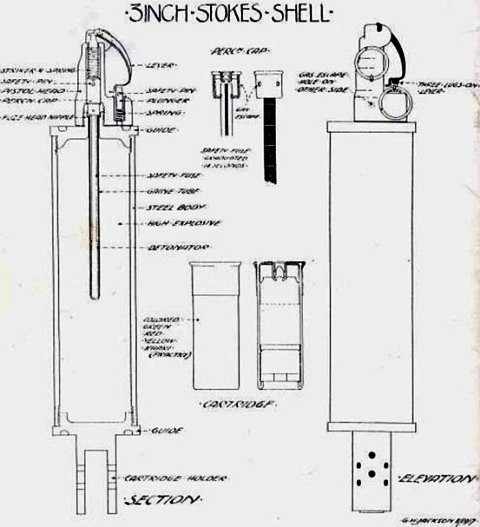The Man Launched (ML) 3″ Stokes Anti-aircraft Mortar
Frederick Wilfred Scott Stokes – who later became Sir Wilfred Stokes KBE – designed the mortar in January 1915.
The British Army was at the time trying to develop a weapon that would be a match for the Imperial German Army’s Minenwerfer mortar, which was in use on the Western Front.
Stokes’s design was initially rejected in June 1915 because it was unable to use existing stocks of British mortar ammunition, and it took the intervention of David Lloyd George (at that time Minister of Munitions) and Lieutenant-Colonel J. C. Matheson of the Trench Warfare Supply Department (who reported to Lloyd George) to expedite manufacture of the Stokes mortar.
The Stokes mortar was a simple weapon, consisting of a smoothbore metal tube fixed to a base plate (to absorb recoil) with a lightweight bipod mount.
When a mortar bomb was dropped into the tube, an impact sensitive primer in the base of the bomb would make contact with a firing pin at the base of the tube, and detonate, firing the bomb towards the target.
Below are extracts from Australian reports
“Lieutenant F Brand of the 7th Light Trench Mortar Battery conducted experiments in the use of the Stokes Mortar as an anti aircraft weapon in November 1917. The Stokes was fired with a barrel and base plate only, the number one positioning the portar by hand using a sight he improvised. I Anzac Corps School carried out further tests. The general impression of this innovation was summed up by Brigadier General Charles Rosenthal who felt that the lack of a reliable fuze, the variations of range and the slowness of the bomb relative to an aircraft it was most unlikely that an enemy aircraft could ever be brought down by a Stokes Mortar” “The British and Canadians continued to search for more effective ways of defending themselves against enemy aircraft. following the German lead, the First Army discussed the possibility of using three-inch Stokes mortars against airplanes, and in May 1918 the 2nd Division carried out experiments to determine the mortar’s effectiveness against low-flying aircraft…”












Sir Wilfred Stokes. Stokes Mortar Bomb.For training.



Men-at-Arms Series.
British Territorial Units 1914-18.

